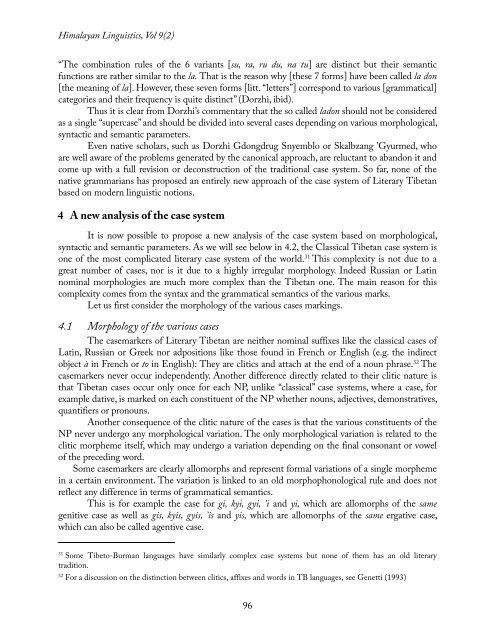The Classical Tibetan cases and their transcategoriality
The Classical Tibetan cases and their transcategoriality
The Classical Tibetan cases and their transcategoriality
Create successful ePaper yourself
Turn your PDF publications into a flip-book with our unique Google optimized e-Paper software.
Himalayan Linguistics, Vol 9(2)<br />
“<strong>The</strong> combination rules of the 6 variants [su, ra, ru du, na tu] are distinct but <strong>their</strong> semantic<br />
functions are rather similar to the la. That is the reason why [these 7 forms] have been called la don<br />
[the meaning of la]. However, these seven forms [litt. “letters”] correspond to various [grammatical]<br />
categories <strong>and</strong> <strong>their</strong> frequency is quite distinct” (Dorzhi, ibid).<br />
Thus it is clear from Dorzhi’s commentary that the so called ladon should not be considered<br />
as a single “supercase” <strong>and</strong> should be divided into several <strong>cases</strong> depending on various morphological,<br />
syntactic <strong>and</strong> semantic parameters.<br />
Even native scholars, such as Dorzhi Gdongdrug Snyemblo or Skalbzang ’Gyurmed, who<br />
are well aware of the problems generated by the canonical approach, are reluctant to ab<strong>and</strong>on it <strong>and</strong><br />
come up with a full revision or deconstruction of the traditional case system. So far, none of the<br />
native grammarians has proposed an entirely new approach of the case system of Literary <strong>Tibetan</strong><br />
based on modern linguistic notions.<br />
4 A new analysis of the case system<br />
It is now possible to propose a new analysis of the case system based on morphological,<br />
syntactic <strong>and</strong> semantic parameters. As we will see below in 4.2, the <strong>Classical</strong> <strong>Tibetan</strong> case system is<br />
one of the most complicated literary case system of the world. 31 This complexity is not due to a<br />
great number of <strong>cases</strong>, nor is it due to a highly irregular morphology. Indeed Russian or Latin<br />
nominal morphologies are much more complex than the <strong>Tibetan</strong> one. <strong>The</strong> main reason for this<br />
complexity comes from the syntax <strong>and</strong> the grammatical semantics of the various marks.<br />
Let us first consider the morphology of the various <strong>cases</strong> markings.<br />
4.1 Morphology of the various <strong>cases</strong><br />
<strong>The</strong> casemarkers of Literary <strong>Tibetan</strong> are neither nominal suffixes like the classical <strong>cases</strong> of<br />
Latin, Russian or Greek nor adpositions like those found in French or English (e.g. the indirect<br />
object à in French or to in English): <strong>The</strong>y are clitics <strong>and</strong> attach at the end of a noun phrase. 32 <strong>The</strong><br />
casemarkers never occur independently. Another difference directly related to <strong>their</strong> clitic nature is<br />
that <strong>Tibetan</strong> <strong>cases</strong> occur only once for each NP, unlike “classical” case systems, where a case, for<br />
example dative, is marked on each constituent of the NP whether nouns, adjectives, demonstratives,<br />
quantifiers or pronouns.<br />
Another consequence of the clitic nature of the <strong>cases</strong> is that the various constituents of the<br />
NP never undergo any morphological variation. <strong>The</strong> only morphological variation is related to the<br />
clitic morpheme itself, which may undergo a variation depending on the final consonant or vowel<br />
of the preceding word.<br />
Some casemarkers are clearly allomorphs <strong>and</strong> represent formal variations of a single morpheme<br />
in a certain environment. <strong>The</strong> variation is linked to an old morphophonological rule <strong>and</strong> does not<br />
reflect any difference in terms of grammatical semantics.<br />
This is for example the case for gi, kyi, gyi, ’i <strong>and</strong> yi, which are allomorphs of the same<br />
genitive case as well as gis, kyis, gyis, ’is <strong>and</strong> yis, which are allomorphs of the same ergative case,<br />
which can also be called agentive case.<br />
31 Some Tibeto-Burman languages have similarly complex case systems but none of them has an old literary<br />
tradition.<br />
32 For a discussion on the distinction between clitics, affixes <strong>and</strong> words in TB languages, see Genetti (1993)<br />
96
















